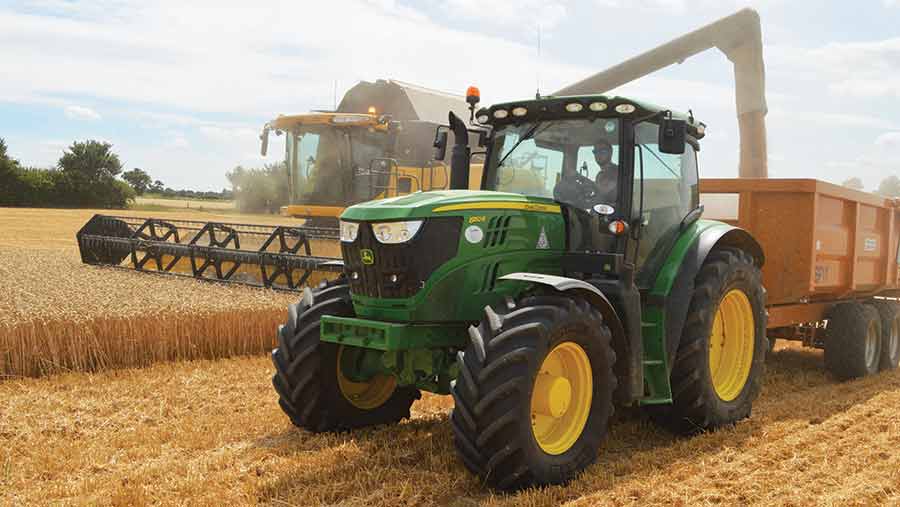Swing to bread wheats seen as variety choice widens
 © Tim Scrivener
© Tim Scrivener More than one-quarter of the winter wheat area this autumn is set to be drilled with breadmaking varieties as a new generation of high-yielding milling wheats nibbles away at the share held by feed wheats.
New variety Illustrious joins Skyfall, Crusoe and Trinity this autumn to accelerate the swing to milling wheats as breadmaking groups are about to sign contracts for the incoming new variety.
Experts believe these breadmaking varieties will take 25-26% of the certified seed market this autumn compared with 23% of the crop in the ground currently, and the overall share could be as high as 26.5% with a lot of farm-saved Skyfall and Crusoe predicted.
See also: New breadmaking wheats yield over 12t/ha in Kent
The breadmaking groups will have more wheat to chose from and hence premiums over feed wheat will come under pressure, but growers are being urged to focus on marketable wheat rather than growing a mountain of feed grain.
Warburtons
Bob Beard, cereal development director at breadmaker Warburtons, is about to issue contracts for Illustrious through co-operative Openfield, and add it to the group’s four other contracted varieties – Skyfall, Crusoe, Edgar and spring wheat Lennox.
“There is a pent-up demand from growers to try something new, especially with current disease pressures in the wheat crop,” he says.
Mr Beard believes if Illustrious produces quality grain, there is grower acceptance and a reasonable premium, the variety could make up 40% of the group’s buying programme.
Warburtons buys about 350,000t of wheat annually, and although 60% is imported, virtually all of its home-grown wheat is bought under contracts with growers.
Hovis
Britain’s biggest breadmaker, Hovis, buys about 800,000t of milling wheat annually and tries to use 100% home-grown wheat – it manages well over 80% at present.
Peter Jones, national wheat manager at the group, says he likes Illustrious because of its consistency in breadmaking and its ability to blend well with lower-quality wheats.
“I have a list of preferences for varieties and Illustrious comes at the top of that list, but with more varieties to select from, price premiums could come under pressure,” he says.
Hovis has not issued any contracts for Illustrious, but it says its consistency and ability to bake well at low protein levels could see it start to replace Cordiale. The group currently buys all varieties classed as Group 1 breadmakers as well as Group 2 variety Cordiale.
With the rising supply of milling wheat, the premium for 2016 new-harvest crop has shrunk to about £15/t, from the previous season’s £30-35/t, and current old-crop is even lower at a £10-12/t premium.
Surplus wheat
Jonathan Lane, trading director at grain trader Gleadell, says growers need to focus on marketable grain as the UK is unlikely to export all its 3m tonne surplus of feed wheat this season as only 2m tonnes has been exported so far.
“With feed wheats there is only one market, but with milling wheats there are a number of different options such as export, breadmaking and feed,” he says.
Simon Howell, manager director of RAGT – the group which bred Skyfall and Illustrious – says there should be 9,000t of seed for Illustrious available to drill this autumn.
“This could amount to 5% of the certified seed market, but we believe it will manage about a 3-4% share,” he adds.
Market share
Barry Barker, national arable seeds product manager at distributor Agrii, says at a time when growers are questioning their fungicide costs, Illustrious could do well as it has a good resistance score of 6 for septoria – wheat’s most damaging disease – similar to Skyfall and Crusoe.
He expects Group 1 breadmaking varieties to make up 26-26.5% of the overall winter wheat seed market this autumn taking into account farm-saved seed.
Simon Oxley, senior research manager at AHDB, points out that Illustrious has the highest untreated fungicide yield of the six Group 1 breadmaking varieties on the Recommended List and comes out top when scored for agronomic merit.
This weighs each variety in terms of relative risk – for example, septoria resistance is given a high rating. This puts new varieties such as Skyfall, Illustrious, Crusoe and Trinity in the low-risk category and older Group 1 varieties Gallant and Solstice and the Group 2 variety Cordiale in the high-risk area.
All the above speakers were attending a RAGT-organised briefing to give a market review of its new variety Illustrious.
AHDB Recommended List 2016-17 |
||
|
Variety |
Fungicide yield |
Non-fungicide yield |
|
Group 1 winter wheats |
||
|
Skyfall |
101 |
87 |
|
Trinity |
101 |
82 |
|
Illustrious |
100 |
90 |
|
Crusoe |
98 |
85 |
|
Gallant |
97 |
68 |
|
Solstice |
96 |
67 |
|
Group 2 winter wheats |
||
|
Cordiale |
97 |
71 |

